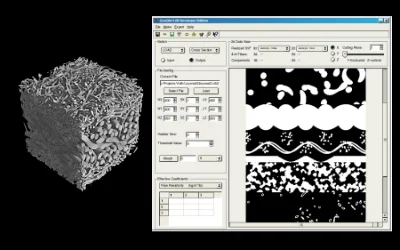In case of depth filtration in fibrous filter media, pressure drop, permeability, filter efficiency, and filter lifetime depend strongly on the micro structure. In addition to the filter mechanisms which are present already for a single fiber we also simulate sieving effects and electrostatic forces that are highly dependent on the geometry of the material. The procedure decouples into several steps: First individual layers of the fibrous filter media are modeled and then stacked into a random three-dimensional representation with given mean properties such as porosity, fiber types and fiber directions. Next, the air flow through the media is computed by solving the steady Stokes equations, and the electric field given by surface charges on the fibers is computed by solving a Poisson problem with singular source terms and appropriate boundary conditions. Then, a stochastic ordinary differential equation models Brownian motion, friction with the air, inertia of particles due to mass, as well as attraction or repulsion due to electric forces. Particles may collide with fibers and stick due to adhesion or bounce off if they have enough energy. They may also be sieved by being stuck between three or more fibers. By iterating this procedure, and computing new flow fields after significant amounts of particles were filtered, even filtration by previously filtered particles is simulated and the clogging and pressure drop of filters can be estimated.
